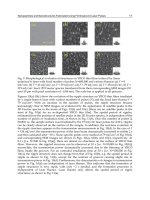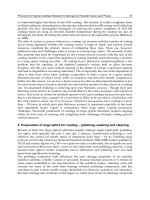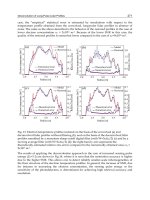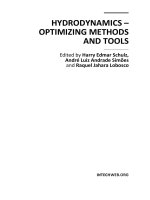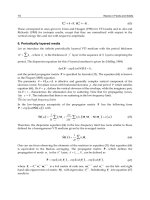Waves in fluids and solids Part 1 pot
Bạn đang xem bản rút gọn của tài liệu. Xem và tải ngay bản đầy đủ của tài liệu tại đây (616.64 KB, 25 trang )
WAVES IN FLUIDS
AND SOLIDS
Edited by Rubén Picó Vila
Waves in Fluids and Solids
Edited by Rubén Picó Vila
Published by InTech
Janeza Trdine 9, 51000 Rijeka, Croatia
Copyright © 2011 InTech
All chapters are Open Access articles distributed under the Creative Commons
Non Commercial Share Alike Attribution 3.0 license, which permits to copy,
distribute, transmit, and adapt the work in any medium, so long as the original
work is properly cited. After this work has been published by InTech, authors
have the right to republish it, in whole or part, in any publication of which they
are the author, and to make other personal use of the work. Any republication,
referencing or personal use of the work must explicitly identify the original source.
Statements and opinions expressed in the chapters are these of the individual contributors
and not necessarily those of the editors or publisher. No responsibility is accepted
for the accuracy of information contained in the published articles. The publisher
assumes no responsibility for any damage or injury to persons or property arising out
of the use of any materials, instructions, methods or ideas contained in the book.
Publishing Process Manager Sandra Bakic
Technical Editor Teodora Smiljanic
Cover Designer Jan Hyrat
Image Copyright Alexey Chechulin, 2011. Used under license from Shutterstock.com
First published September, 2011
Printed in Croatia
A free online edition of this book is available at www.intechopen.com
Additional hard copies can be obtained from
Waves in Fluids and Solids, Edited by Rubén Picó Vila
p. cm.
ISBN 978-953-307-285-2
free online editions of InTech
Books and Journals can be found at
www.intechopen.com
Contents
Preface IX
Part 1 Elastic Waves in Solids 1
Chapter 1 Acoustic Waves in Layered Media
- From Theory to Seismic Applications 3
Alexey Stovas and Yury Roganov
Chapter 2 Soliton-Like Lamb Waves in Layered Media 53
I. Djeran-Maigre and S. V. Kuznetsov
Chapter 3 Surface and Bulk Acoustic Waves in Multilayer Structures
69
V. I. Cherednick and M. Y. Dvoesherstov
Chapter 4 The Features of Low Frequency
Atomic Vibrations and Propagation
of Acoustic Waves in Heterogeneous Systems 103
Alexander Feher, Eugen Syrkin, Sergey Feodosyev,
Igor Gospodarev, Elena Manzhelii, Alexander Kotlar
and Kirill Kravchenko
Chapter 5 Multiple Scattering of Elastic Waves
in Granular Media: Theory and Experiments 127
Leonardo Trujillo, Franklin Peniche and Xiaoping Jia
Chapter 6 Interface Waves 153
Hefeng Dong and Jens M. Hovem
Chapter 7 Acoustic Properties of the Globular Photonic Crystals 177
N. F. Bunkin and V. S. Gorelik
Part 2 Acoustic Waves in Fluids 209
Chapter 8 A Fourth-Order Runge-Kutta Method
with Low Numerical Dispersion for
Simulating 3D Wave Propagation 211
Dinghui Yang, Xiao Ma, Shan Chen and Meixia Wang
VI Contents
Chapter 9 Studies on the Interaction Between
an Acoustic Wave and Levitated Microparticles 241
Ovidiu S. Stoican
Chapter 10 Acoustic Waves in Bubbly Soft Media 257
Bin Liang, Ying Yuan, Xin-ye Zou and Jian-chun Cheng
Chapter 11 Inverse Scattering in the Low-Frequency
Region by Using Acoustic Point Sources 293
Nikolaos L. Tsitsas
Preface
Acoustics is a discipline that deals with many types of fields wave phenomena.
Originally the field of Acoustics was consecrated to the sound, that is, the study of
small pressure waves in air detected by the human ear. The scope of this field of
physics has been extended to higher and lower frequencies and to higher intensity
levels. Moreover, structural vibrations are also included in acoustics as a wave
phenomena produced by elastic waves. This book is focused on acoustic waves in
fluid media and elastic perturbations in heterogeneous media.
Acoustic wave propagation in layered media is very important topic for many
practical applications including medicine, optics and applied geophysics. The key
parameter controlling all effects in layered media is the scaling factor given by the
ratio between the wavelength and the layer thickness. Existing theory mostly covers
the solutions derived for the low-frequency and high-frequency limits. In practice, the
wavelength could be comparable with the layer thickness, and application of both
frequency limits is no longer valid. The frequency-dependent effects for acoustic
waves propagating through the layered media are analyzed.
Solitons, or by the original terminology “waves of translation”, are a special kind of
hydrodynamic waves that can arise and propagate in narrow channels as solitary
waves, resembling propagation of the wave front of shock waves. These waves can
propagate without considerable attenuation, or change of form; or diminution of their
speed. Motion of these waves can be described by a non-linear KdV differential
equation. Soliton-like lamb waves are analyzed in the long-wave limits of Lamb waves
propagating in elastic anisotropic plates.
The application of various layers on a piezoelectric substrate is a way of improving the
parameters of propagating electroacoustic waves. For example, a metal film of certain
thickness may provide the thermal stability of the wave for substrate cuts,
corresponding to a high electromechanical coupling coefficient. The overlayer can vary
the wave propagation velocity and, hence, the operating frequency of a device. The
effect of the environment (gas or liquid) on the properties of the wave in the layered
structure is used in sensors. The layer may protect the piezoelectric substrate against
undesired external impacts. Multilayer compositions allow to reduce a velocity
dispersion, which is observed in single-layer structures. In multilayer film bulk
acoustic wave resonators (FBAR) many layers are necessary for proper work of such
devices. Wave propagation characteristics in multilayer structures are analyzed by
means of general methods of numerical calculations of the surface and bulk acoustic
wave parameters in arbitrary multilayer structures.
Crystalline and disordered systems are analyzed as very peculiar systems. The most
important elementary excitations appearing in them are acoustic phonons, which
characterize vibration states in heterogeneous structures. In such systems, the
crystalline regularity in the arrangement of atoms is either absent or its effect on the
physical properties of the systems is weak, affecting substantially the local spectral
functions of different atoms forming this structure.
Granular materials consist of a collection of discrete macroscopic solid particles
interacting via repulsive contact forces. Classical examples are sand, powders, sugar,
salt and gravel, which range from tens of micrometers to the macroscopic scale. Their
physical behavior involves complex nonlinear phenomena, such as non equilibrium
configurati. The elastic wave propagation in confined granular systems under external
load is developed from both experimental and theoretical viewpoints.
Shear waves (S-wave) are essential in the field of seafloor geotechnical applications as
they propagate in solids. More specifically interface waves and the use of the interface
waves are important to estimate shear wave speed in the sediments as it provides a
good indicator of sediment rigidity, as well as for sediment characterization, seismic
exploration, and geohazard assessment. In addition, for environments with high
seabed S-wave speeds, S-wave conversion from the compressional wave (also called P-
wave) at the seafloor can represent an important ocean acoustic loss mechanism which
must be accounted for in propagation modeling and sonar performance predictions.
Phononic Crystals are characterized by spatial periodic modulations of the sound
velocity caused by the presence of the periodically settled elements of various
materials (metals, polymers etc.) inside the sample. The properties of acoustic waves in
Phononic Crystals are in many respects similar to the properties of electromagnetic
waves in Photonic Crystals. Periodic media can be characterized by the dispersion
dependences ω(k) for acoustic waves together with the dispersion dependences of
their group velocities and effective mass of the corresponding acoustic phonons. The
results of the theoretical analysis and the data of experimental studies of the optical
and acoustic phenomena in PTC and PNC, including the studies of spectra of non-
elastic scattering of light together with the experiments to observe the stimulated light
scattering accompanying by the coherent oscillations of globules are reported.
The numerical solutions of the acoustic-wave equation via finite-differences, finite-
elements, and other related numerical techniques are valuable tools for the simulation
of wave propagation. These modeling techniques for the 1D and 2D cases are typically
used as support for a sound interpretation when dealing with complex geology, or as a
benchmark for testing processing algorithms, or used in more or less automatic
Contents XI
inversion procedure by perturbation of the parameters characterizing the elastic
medium until the synthetic records fit the observed real data. It is not advisable to
apply these techniques in large-scale computation, especially for a large scale 3D
simulation of seismic wave propagation because of an intensive use of Central
Processing Unit (CPU) time and the requirement of a large amount of direct-access
memory. A 3D numerical method is proposed to effectively suppress the numerical
dispersion caused by the discretization of the acoustic- and elastic-wave equations
through using both the local spatial difference-operator and the fourth-order Runge-
Kutta (RK) method so that the numerical technique developed in this chapter has
rapid computational speed and can save the memory storage.
The electrode systems generating a quadrupole electric field, having both static and
variable components, under certain conditions, allow to maintain the charged particles
in a well defined region of space without physical solid contact with the wall of a
container. This process is sometime called levitation. Usually, these kinds of devices
are known as quadrupole traps. The possibility to manipulate the stored
microparticles by using an acoustic wave is investigated by experimental means. That
means both controlling their position in space and performing a further selection of
the stored microparticles.
There exists a special class of solid media called soft media (or weakly compressible
media), for which the inequality λ>>μ is satisfied (λ and μ are the Lamé coefficients).
Such media with very small shear stiffness are dynamically similar to liquids to a great
extent and exhibit strongly a “water-like” characteristic. The class of soft media
includes many common media in the fields of scientific research and practical
applications (e.g. soft rubbers, tissues, or biomimetic materials), and air bubbles are
often introduced due to artificial or non-artificial reasons. Propagation of acoustic
waves in a bubbly soft medium is particularly different from that of a usual solid
medium containing bubbles.
The interaction of a point-source spherical acoustic wave with a bounded obstacle
possesses various attractive and useful properties in direct and inverse scattering
theory. More precisely, concerning the direct scattering problem, the far-field
interaction of a point source with an obstacle is, under certain conditions, stronger
compared to that of a plane wave. In inverse scattering problems the distance of the
point-source from the obstacle constitutes a crucial parameter, which is encoded in the
far-field pattern and is utilized appropriately for the localization and reconstruction of
the obstacle's physical and geometrical characteristics.
Rubén Picó Vila
Polytechnic University of Valencia
Spain
Part 1
Elastic Waves in Solids
1
Acoustic Waves in Layered Media
- From Theory to Seismic Applications
Alexey Stovas
1
and Yury Roganov
2
1
NTNU, Trondheim,
2
USGPI, Kiev,
1
Norway
2
Ukraine
1. Introduction
Acoustic wave propagation in layered media is very important topic for many practical
applications including medicine, optics and applied geophysics. The key parameter
controlling all effects in layered media is the scaling factor given by the ratio between the
wavelength and the layer thickness. Existing theory mostly covers the solutions derived for
the low-frequency and high-frequency limits. In the first limit, when the wavelength is
much larger than the layer thickness, the layered medium is substituted by an effective
medium with the properties given by special technique called the Backus averaging. In the
second limit, when the wavelength is much smaller than the layer thickness, we can use the
ray theory to compute both reflection and transmission responses.
In practice, the wavelength could be comparable with the layer thickness, and application of
both frequency limits is no longer valid. In this chapter, we will mainly focus on the
frequency-dependent effects for acoustic waves propagating through the layered media.
We show that there are distinct periodically repeated patterns consisted of the pass- and
stop-bands of very complicated configuration defined in frequency-slowness or frequency-
group angle domain that control the reflection and transmission responses. The edges
between the pass- and stop-bands result in the caustics in the group domain. The quasi-
shear waves in a homogeneous transversely isotropic medium could also results in the high-
frequency caustics, but for the layered media, all wave modes can result in frequency-
dependent caustics. The caustics computed for a specific frequency differ from those
observed at the low- and high-frequency limits. From physics point of view, the pass-bands
correspond to the effective medium, while the stop-bands correspond to the resonant
medium. We distinguish between the effects of scattering and intrinsic attenuation in
layered media. The propagation of acoustic waves in a layered medium results in the energy
loss due to scattering effect. The intrinsic attenuation is an additional effect which plays very
important role in seismic data inversion. We provide the theoretical and numerical study to
compare both effects for a periodically layered medium. We also investigate the complex
frequency roots of the reflection/transmission responses. We also derive the phase velocity
approximations in a layered medium. As the trial model for layered medium, we widely use
the periodically layered medium with the limited number of parameters. The propagation of
acoustic waves through a periodic layered medium is analyzed by an eigenvalue
Waves in Fluids and Solids
4
decomposition of the propagator matrix. This reveals how the velocity and attenuation of
the layered medium vary as function of the periodic structure, material parameters and
frequency. We show that there is one more parameter controlling the wave propagation
apart of the wavelength to layer thickness ratio that is the acoustic contrast between the
layers. Multiple scattering in finely layered sediments is important in stratigraphic
interpretation in seismic, matching of well log-data with seismic data and seismic
modelling. Two methods have been used to treat this problem in seismic applications: the
O’Doherty-Anstey approximation and Backus averaging. The O’Doherty-Anstey
approximation describes the stratigraphic filtering effects, while the Backus averaging
defines the elastic properties for an effective medium from the stack of the layers.
Using numerical examples, we show that there is a transition zone between the effective
medium (low-frequency limit) and the time-average medium (high-frequency limit) and that
the width of this zone depends on the strength of the reflection coefficient series. Assuming
that a tubidite reservoir can be approximated by a stack of thin shale-sand layers we use
standard AVO-attributes to estimate net-to-gross and oil saturation. Necessary input is
Gassmann rock physics properties for sand and shale as well as the fluid properties for
hydrocarbons. Required seismic input is AVO intercept and gradient. The method is based
upon thin layer reflectivity modeling. It is shown that random variability in thickness and
seismic properties of the thin sand and shale layers does not change the AVO attributes at top
and base of the turbidite reservoir sequence significantly. The method is tested on seismic data
from offshore Brazil, and the results show reasonable agreement between estimated and
observed net-to-gross and oil saturation. The methodology can be further developed for
estimating changes in pay thickness from time lapse seismic data. We propose the method of
computation seismic AVO attributes (intercept and gradient) from ultra-thin geological model
based on the SBED modelling software. The SBED software is based on manipulating sine-
functions, creating surfaces representing incremental sedimentation. Displacement of the
surfaces creates a three dimensional image mimicking bedform migration, and depositional
environments as diverse as tidal channels and mass flows can be accurately recreated. The
resulting modelled deposit volume may be populated with petrophysical information,
creating intrinsic properties such as porosity and permeability (both vertical and horizontal).
The Backus averaging technique is used for up-scaling within the centimetre scale (the
intrinsic net-to-gross value controls the acoustic properties of the ultra-thin layers). It results in
pseudo-log data including the intrinsic anisotropy parameters. The synthetic seismic
modelling is given by the matrix propagator method allows us to take into account all pure
mode multiples, and resulting AVO attributes become frequency dependent. Within this ultra-
thin model we can test different fluid saturation scenarios and quantify the likelihood of
possible composite analogues. This modelling can also be used for inversion of real seismic
data into net-to-gross and fluid saturation for ultra-thin reservoirs.
There are many other issues related to wave propagation in layered media we do not discuss in
this chapter. For further reading we suggest several books (Aki&Richards, 1980; Brekhovskih,
1960; Kennett, 1983; Tsvankin, 1995) that cover the problems we did not touch here.
2. System of differential equations
To describe the dynamic of the wave propagation in an elastic medium, it is common to use
the Hook’s law that defines the linear relation between the stress tensor
ij
and the strains
tensor
p
q
e ,
Acoustic Waves in Layered Media - From Theory to Seismic Applications
5
ij ijpq pq
ce
, (1)
where
1
2
p
q
pq
qp
uu
e
x
x
and
ijpq
c is the stiffness tensor. If there are no volume forces
within the medium, we can write the moment equation in the following way (Aki and
Richards, 1980)
2
2
ij
i
j
u
tx
. (2)
In equation (1) and (2), it is assumed that the summation is performed over the repeatable
indices. Since the tensor
ijpq
c is symmetrical with respect to index changing
ij pq ,
ij , pq , the relation (1) can be written as
p
ij ijpq
q
u
c
x
. (3)
If we denote
i
i
u
v
t
as the velocity of the particle movement, the equations (2) and (3) can
be given as
ij
i
j
v
tx
, (4)
ij p
ijpq
q
v
c
tx
. (5)
We can apply the Fourier transform for the variables
,
1
x
,
2
x
to equations (4) and (5)
according to the following relations
11 2 2
12 12 12
3
1
,, ,,
8
ipxpxt
f
pp fxxte dxdxdt
,
11 2 2
2
12 1 2 1 2
,, ,,
ipxpxt
f
xxt f pp e dpdpd
.
After substituting the derivatives on
1
x
,
2
x
, t with the coefficients
1
ip
,
2
ip
, i
, and
excluding the variables
11
,
12
,
22
, the system of equations (4)-(5) can be given in a vector-
matrix form
d
i
dz
b
Mb
, (6)
where vector
123132333
,,, , ,
T
vvv
b ,
3
zx
, and matrix
M
is defined as
1
33
T
AC
M
BA
, (7)
Waves in Fluids and Solids
6
with
,
,
mn mp nq
pq cC ,
1
33 1 31 2 32
pp
AC C C and
1
3333
,1,2
mn m n mn
mn
pp
BCCCCI,
where
1
p
and
2
p
are the horizontal slowness in
1
x
and
2
x
direction, respectively, and
is
the density. The matrices
1
33
C and
B
are symmetrical, and matrix
M
satisfies the equation
T
KMK M , (8)
where
T
M is transposed matrix,
0I
K
I0
and I is the unit 3x3 matrix. Equation (6)
describes the wave propagation in the vertically heterogeneous medium with all parameters
being dependent on z-coordinate only. Note, even if the parameters
z
and
ijpq
cz are
discontinuous functions, the components of the vector
b remain continuous functions of
depth. If the medium is a homogeneous transversely isotropic with vertical symmetry axis
(a VTI medium), the propagation of waves in qP-qSV system is independent from the qSH-
waves propagation. In this case, there are two equations (6): with dimension 4x4 (qP-qSV
system) and with dimension 2x2 (qSH wave). For vertical propagation, equation (6) is
reduced into three independent equations (for qP-, qSV- and qSH-waves). The analytical
form of matrix
M for different types of media can be found in Aki and Richards (1980),
Braga and Herrmann (1992) and Fryer and Frazer (1987).
3. Propagator matrix
The propagator matrix is the matrix
06
,zz PGLC that is the solution of initial-value
problem
0
0
,
,
zz
izz
z
P
MP
,
00
,zz
PI
. (9)
The propagator matrix satisfies the Volterra integral equation
0
00
,,
z
z
zz z d
PIMP , (10)
that can be solved by using the Picard iteration. This leads to the Peano series for
0
,zzP
(Peano, 1888; Pease, 1965)
1
000
0111221
,
zz
zzz
zz d d d
PIM MM . (11)
The series (11) converges if
c
M for all
0
,zz
, where is some matrix norm. If
MM, the matrix with constant elements, than equation (11) is reduced to the exponent
00
,expzz i z z
PM
. (12)
From equation (9), it follows that for any vector
0
zb
, the vector
00
,zzzzbP b
is the
solution of equation (6). By substituting the basis vectors
i
e , 1, 2, 3i
, instead of the vector
Acoustic Waves in Layered Media - From Theory to Seismic Applications
7
0
zb , we can prove that the columns of matrix
0
,zzP are the linear independent
solutions of equation (6), i.e. the propagator matrix describes the fundamental system of
solutions of equation (6). Since,
220021100
,,,zzzzzzzzzbP bP P b, (13)
than,
20 21 10
,,,zz zz zzPPP. (14)
If the medium consists of N layers with matrices
i
M and layer thickness
i
h , the equations
(12)-(14) gives the propagator matrix from the stack of the layers
011
, exp exp
NNN
z z ih ih
PMM, (15)
where
01
NN
zzh h.
Equation (15) was used by Haskell (1953) and Thomson (1950) in their works to describe the
wave propagation in a layered isotropic medium.
4. Symmetry relations
Let us assume that matrices
k
M can be diagonalized by using a similarity transformation,
() 1
diag
m
kk k k
ME E. In this case,
() 1
exp diag exp
m
kk k kk k
ih ih
ME E. The
columns of matrix
k
E are the polarization vectors for all types of wave propagating in layer
k with horizontal slownesses
1
p
and
2
p
, while
()m
k
are corresponding vertical slownesses.
Therefore, the vector
1
() ()
k
zz
wEb
consists of up- and down-going wave amplitudes in
layer k with
111
kk
hhzhh
. Let us denote by
0
E and
1N
E the matrices that
consist of the eigen-vectors of matrices
0
M and
1N
M , respectively, which define the
properties of the half-spaces surrounding the stack of layers. The matrix
1
10
N
QEPE (16)
is called the amplitude propagator matrix, since the equation
10N
wQw provides the
linear relation between the amplitudes over and under the stack of layers for all wave types.
The amplitude propagator matrix can be blocked by 3x3 sub-matrices,
1,2
ij
ij
QQ , and the
amplitude vectors
0
w and
1N
w can be blocked by three-component sub-vectors,
corresponding to up- and down-going waves of different type,
0
0
0
u
w
d
,
1
1
1
N
N
N
u
w
d
. (17)
Therefore, we can write
10
11 21
10
21 22
N
N
uu
dd
. (18)
Waves in Fluids and Solids
8
From equation (18), it follows that the amplitudes of waves going away from the stack of
layers:
0
u and
1N
d can be computed from the amplitudes of waves coming to the stack of
layers:
1N
u and
0
d ,
10
01
NDU
DU N
dTRd
uRTu
, (19)
where
1
22 21 11 12D
TQ QQQ, (20)
1
21 11U
RQQ, (21)
1
11 12D
RQQ, (22)
1
11U
TQ. (23)
The matrices
U
R ,
U
T and,
D
R ,
D
T are called the reflection and transmission matrices for up-
and down-going wave, respectively (Figure 1). From equations (20)-(23), the amplitude
propagator matrix can be rewritten as
11
11
UUD
UU D UU D
TTR
Q
RT T RTR
. (24)
The matrix
DU
DU
TR
S
RT
(25)
is called the scattering matrix (Ursin, 1983) and contains all reflection and transmission
coefficients for up- and down-going waves of all type as sub-matrices. If the layers posses the
VTI (transverse isotropy with vertical symmetry axis) symmetry, the following relation is valid
T
QJQ J, (26)
where
0I
J
I0
. In order to prove the relation (26), we represent the amplitude
propagator matrix
Q as
10
NN
QFΛΛF , where
1
1
kkk
FEE,
()
diag
m
kk
Λ and
() ()
exp
mm
kkk
ih
. To validate the relation (26), it is sufficient to prove that
T
kk
Λ JJ
and
T
kk
FJF J. The first equality follows from the fact that the matrix
k
Λ is diagonal, and
the elements of matrix
k
Λ are symmetric,
(3) ()
1
mm
kk
. The second equality can be proven
by substitution of equations (35) and (36) for matrices
k
E and
1
1
k
E into this equation and
Acoustic Waves in Layered Media - From Theory to Seismic Applications
9
using relations (37). The symmetry relations for reflection and transmission matrices for
stack of layers sandwiched between two half-spaces,
T
D
D
RR,
T
UU
RR,
T
D
U
TT, (27)
can be derived by substitution the expression for amplitude propagator matrix
Q from
equation (24) into equation (26). It is assumed that all layers and half-spaces posses the VTI
symmetry, and the presence of attenuation is allowed. The symmetry relations (27) are also
derived by Ursin (1983) for a stack of isotropic layers. If we consider the single interface
between the half-spaces, than the diagonal sub-matrices in equation (24) are equal (see
equations (35) and (36)), and, therefore,
11
UU U D
RT TR and
11
UDUUD
TTRTR (Ursin,
1983). These relations result in
0
UU DU
TR R T ,
2
DU U
TT R I. (28)
By using
1
UUDU
RTRT and equations (27) we can derive two additional symmetry
relations
0
UD D D
RT TR ,
2
UD D
TT R I. (29)
The symmetry relations (28) and (29) are derived by Frasier (1970), Kennett et al. (1978) and
Ursin (1983).
5. Reflection and transmission responses of layered transversely isotropic
media
This chapter is mostly based on the paper Stovas and Ursin (2003). The major point in this
chapter is wave field decomposion into up- and down-going waves (Kennett, 1983; Ursin,
1983) scaled such that, for an elastic medium, the vertical energy flux is constant. This
results in important symmetries in the transformation matrix and also in the reflection and
transmission (R/T) coefficients (Chapman, 1994; Ursin and Haugen, 1996). The equations of
motion and Hook’s law in a source free VTI medium (radially symmetric about the vertical,
z axis) for qP- and qSV-waves in
13
X
X plane after applying a Fourier transform can be
expressed as an ordinary first-order matrix-vector differential equation as shown in
equation (6), where
denotes circular frequency,
313331
,,,
T
vv
b is the displacement
velocity - stress vector, the superscript ""T indicating the transpose, and the matrix M has
the blocked structure,
0
0
A
M
B
, (30)
composed of the 2x2 symmetric matrices A and B are given by
11
33 13 33
1
1221
55
13 33 11 13 33
,
cpcc
p
pc
pc c p c c c
AB, (31)
Waves in Fluids and Solids
10
which are dependent on the horizontal slowness
p , the stiffness coefficients
ij
c from the
stiffness matrix and the density
. In order to decompose into up- and down-going waves
(Ursin, 1983, Ursin and Stovas, 2002), we make the linear transformation
u
bE
d
. (32)
Then equation (6) becomes
i
d
i
dz
u Δ 0FGu
d0Δ GF d
, (33)
where
u
and d are the up- and down-going wave amplitudes, and
,
qP qSV
diag
Δ (34)
contains the vertical slownesses for qP- and qSV-waves,
qP
and
qSV
. The transformation
matrix
11
22
1
2
EE
E
EE
(35)
is normalized with respect to the vertical energy flux so that the inverse has the simple form
11 TT
1
12 21
11 TT
12 21
11
22
EE EE
E
EE EE
. (36)
Matrices
1
E and
2
E posses the symmetries
21 21
TT
EE EE I. (37)
Therefore, the layer propagator matrix can be given as
() ()
1
11 12
() ()
21 11
exp exp
kk
kk
kk
i
ih ih
i
PP
PMEΛ E
PP
, (38)
where
() 1
cos
k
mm m m
h
PE Δ E and
() 1
sin
k
mn m n
h
PE Δ E ,
,, 1,2mnmn
. From equation (37)
and (38), it follows that
() ()
11
11 12
() ()
21 11
exp exp
kk
kk
kk
i
ih ih
i
PP
PMEΛ E
PP
, (39)
and
() 1 1 ()
11 1 1 2 2 22
() 1 1 ()
21212121
() 1 1 ()
12 1 2 1 2 12
cos cos
sin sin
sin sin
T
T
k k
T
T
k k
T
T
k k
hh
hh
hh
PE Δ EE Δ EP
PE Δ EE Δ EP
PE Δ EE Δ EP
. (40)
Acoustic Waves in Layered Media - From Theory to Seismic Applications
11
The product of matrices of this type indicates that the propagator matrix
P for the stack of
layers can be blocked as follows
11 12
21 22
i
i
PP
P
PP
, (41)
where the elements of 2x2 matrices
kl
P are real functions of horizontal slowness p and
frequency
. The elements of matrices
kl
P are even/odd functions of frequency if k+l is
an even/odd number, respectively. Matrix
k
M possesses the following symmetries
,
T
kkk k
KM K M TM T M , (42)
where
I0
T
0I
. Therefore,
1
exp , exp
TT
kkkk kk
ih ih
KP K M P TP T M P . (43)
For an elastic medium, the elements of matrix
k
M are real, and, therefore,
*1
kk
PP, and
equations (43) can be rewritten as
**
,
T
kk kk
KP K P TP T P . (44)
Multiplications of equations (44) for
1, ,kN
, gives similar symmetry relations for
propagator matrix for the stack of layers,
**
,
T
KPK P TPT P . (45)
The scattering matrices
F and G are given by
12 12
21 21
11
,
22
TT TT
dd dd
dz dz dz dz
EE LE
FE E GE E
, (46)
with symmetries
,
TT
FFGG, (47)
so that
F and G have the form
11 12
12 22
0
,
0
g
g
f
g
g
f
FG
. (48)
To compute the scattering matrices
F and G , we express them as functions of
perturbations in the elements of the matrices A and B in equation (31). The eigenvector
matrices satisfy the following equations
21 1 2
,AE E Δ BE E Δ
. (49)
From equations (35) and (36), we obtain
Waves in Fluids and Solids
12
11 22
,
EEGFEEGF
. (50)
Differentiating equations (49) and substituting equations (50), we obtain
11 12
2211
12 22
2211
2
1
2
2
0
1
2
0
qP qP qSV
TT
qP qSV qSV
qP qSV
TT
qP qSV
gg
gg
f
f
ΔGGΔ EAE EBE
ΔFFΔ EAE EBE Δ
. (51)
From equations (51) we can compute all elements of matrices
F and G .
Equation (6) can be solved not only by propagator matrix technique described in previous
chapter, but also by a layer-recursive scheme described in Ursin and Stovas (2002). We let
D
j
R ,
D
j
T ,
Uj
R and
Uj
T denote the R/T matrices for the interface at
j
zz
(Figure 1). For the
layer thickness
1
j
jj
zzz
, the layer propagator matrix is given by
exp
j
jj
iz
L Λ
. (52)
Assume that the generalized reflection matrix from the top of layer j+1 to the bottom of the
stratified medium,
,
DjN
zz
R , is known; then the new reflection matrix up to the top of
layer j is given by the recursive relation (Ursin, 1983)
1
1
,,,
D
jN jDjUjDjN DjDjN Djj
z z zz zz
RLRTRIRRTL
. (53)
It is started with the initial value
,0
DjN
zz
R , satisfying the radiation condition in the
elastic half-space. By considering a plane interface between two homogeneous media, we
can define the transmission and reflection coefficient matrices. Continuity of the wavefields
gives the 2x2 reflection and transmission matrices (Ursin, 1983):
11
2,
DPP DPS DPP DPS
DD
DSP DSS DSP DSS
tt rr
tt rr
TCDRCDCD
, (54)
with
12 12
21 1 2
,
TT
CE EDE E
, (55)
where superscripts
1
and
2
denote the upper and lower medium, respectively.
R
D
T
D
T
U
R
U
I
I
z
z
0
0
Fig. 1. Definition of the reflection and transmission response matrices (Ursin&Stovas, 2002).
Acoustic Waves in Layered Media - From Theory to Seismic Applications
13
The symmetry equations (37) imply that
T
CD I . (56)
Using equation (55), the reflection and transmission matrices are given by
11 22 21 12
12 21 22 11
2
222 2
11 12 21 22 11 21 12 22
2
22 2 2
11 21 12 22 11 12 21 22
det det
2
det det
det( )det
det 1 2
1
det( )det
2det1
D
D
cc cc
cc cc
cccc cccc
cc cc c c c c
CC
T
CC
CD C
C
R
CD C
C
(57)
where
ij
c are elements of matrix C and
2
2222
11 12 21 22
det det det 1 cccc
CD C C . (58)
The matrices
U
R and
U
T can be computed by interchanging the superscripts 1 and 2 or
using the symmetry relations (37) and (56) (Ursin and Stovas, 2001), which gives
1
,
T
UD U DDD
TT R TRT. (59)
The weak-contrast approximations for reflection and transmission matrices an be derived by
assuming weak contrast in elastic parameters above and below the interface. We consider a
plane interface with a discontinuity in the parameters
21
kk k
mm m (60)
and average parameters
21
2
kk
k
mm
m
, (61)
where
1
k
m and
2
k
m characterize the medium above and below the interface, respectively.
To approximate the reflection and transmission matrices in equation (54), we proceed as in
Stovas and Ursin (2001) and expand the matrices
, 1,2, 1,2
j
k
kjE , into second-order
Taylor series with respect to the average medium. This gives the second-order approximations
22 2
11 12 12 11 22 11 12 12 11 22
2 2
22 2
12 11 22 12 22 12 11 22 22 12
11 1
1
22 2
,
11 1
1
22 2
D D
gg f f ggg ggf g fgg
fggg ggf g fgg ggf
TR
. (62)
From the symmetries of the matrices
1
E and
2
E , the second-order derivatives of these
matrices with respect to the medium parameters cancel; therefore they do not appear in the
second-order approximations for the R/T coefficients. In the equations above, the elements
f
and
ij
g
are as defined in equation (46), but the derivatives of the medium parameters
k
dm
dz
are replaced by
k
m
. Neglecting the second-order terms gives the linear approximations

